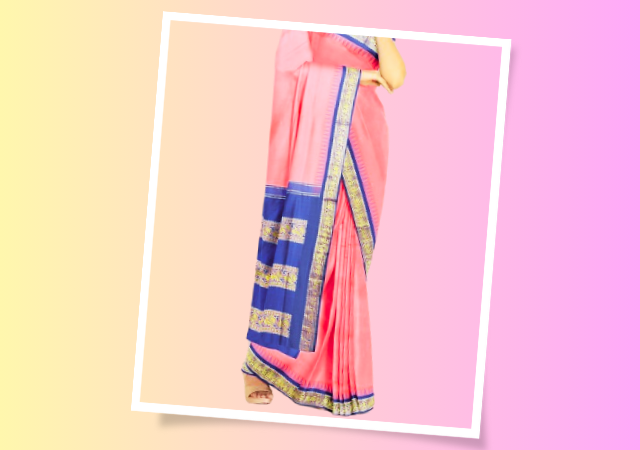What Are Some Tips For Choosing The Right Size Saree?
Introduction
The saree, a quintessential Indian garment, is not just a piece of clothing; it is a cultural symbol and an expression of grace and tradition. Wearing a saree can be a transformative experience, but achieving the perfect look involves more than just choosing a beautiful design. One of the key elements in donning a saree with panache is selecting the right size. This often-overlooked aspect can significantly impact the overall appearance and comfort of the wearer. In this comprehensive guide, we will delve into various tips for choosing the right size saree, considering factors such as body type, saree length, draping styles, fabric choices, and more. Join us on a journey to master the nuances of selecting the perfect size saree, unlocking a world where tradition and contemporary style seamlessly intertwine.
Understanding Body Types

The first step in selecting the right size saree is understanding your body type. Different body shapes require different styles and lengths to enhance the natural curves and create a balanced silhouette.
- Pear-shaped: Those with a pear-shaped body have a narrower upper body and wider hips. Opt for sarees that draw attention to the upper half, balancing the overall look. Consider lighter fabrics and avoid heavy borders around the hips.
- Hourglass: An hourglass figure is characterized by a well-defined waist. Embrace sarees that highlight the waist and curves. Six-yard sarees with medium to heavy fabrics work well for hourglass shapes.
- Apple-shaped: Apple-shaped bodies carry weight around the midsection. Choose sarees that divert attention from the waist, focusing on the upper and lower parts. A well-fitted blouse and a moderately draped pallu can create a flattering look.
- Rectangle-shaped: Rectangular figures have a straight silhouette. Sarees with elaborate borders, pleats, and textures can add volume and create the illusion of curves. Experiment with different draping styles to add dimension.
Saree Length Guide

The length of the saree plays a pivotal role in achieving the desired look. While the standard saree length is six yards, variations like the nine-yard saree have gained popularity. Understanding the appropriate length for your body type is crucial.
- Six yards: The most common length, suitable for various body types. It offers versatility and is easy to manage. Ideal for everyday wear and formal occasions.
- Nine yards: Traditionally worn in regions like South India, the nine-yard saree exudes grandeur and is favored for weddings and festive events. Best suited for taller individuals as it can be overwhelming for shorter frames.
- Other variations: Apart from the standard lengths, sarees come in various sizes, ranging from 5.5 to 8 yards. Consider the occasion and your body type when opting for non-traditional lengths.
Draping Styles and their Influence

The way a saree is draped can significantly impact the overall appearance. Different regions in India boast unique draping styles, each contributing to a distinct aesthetic. Understanding these styles and their compatibility with your body type can help you choose the right size saree.
- Nivi style: Originating from Andhra Pradesh, the Nivi style is the most common way of draping a saree. It is versatile and suits various body types. The pallu can be draped in the front or over the shoulder, creating different looks.
- Bengali style: Characterized by elaborate pleats and a key focus on the pallu, the Bengali style suits individuals with a rectangular or apple-shaped body. It adds volume to the upper body, creating a balanced silhouette.
- Gujarati style: The Gujarati drape involves pleating the pallu at the back and bringing it to the front over the right shoulder. This style is ideal for individuals with an hourglass or pear-shaped figure, accentuating the waist and upper body.
- Maharashtrian style: The Maharashtrian nauvari saree is draped in a unique way, with the saree tucked at the back. This style is suitable for various body types, and the length can be adjusted based on personal preference.
Fabric Considerations
Choosing the right fabric is crucial for comfort and aesthetic appeal. The weight and texture of the fabric can influence the overall drape and appearance of the saree.
- Lightweight fabrics: Fabrics like georgette, chiffon, and silk blends are lightweight and drape well. Ideal for individuals with pear-shaped or apple-shaped bodies as they don’t add unnecessary bulk.
- Heavy fabrics: Banarasi silk, Kanjeevaram silk, and other heavy fabrics are best suited for festive occasions and weddings. Individuals with an hourglass or rectangular figure can carry off these fabrics with elegance.
- Choosing the right fabric for the occasion: Consider the event when selecting the fabric. Lighter fabrics work well for casual or daytime events, while heavy silk sarees are perfect for weddings and formal functions.
Pallu Placement

The pallu, or loose end of the saree, is a focal point in saree styling. Its placement can greatly affect the overall look. Understanding how to adjust the pallu based on your body type is essential.
- Importance of pallu in saree styling: The pallu can be a statement piece, and its placement can draw attention to specific areas. Experiment with different pallu styles to find what suits your body type.
- How to adjust the pallu for a flattering look: For pear-shaped bodies, draping the pallu over one shoulder can balance the silhouette. Hourglass figures can experiment with pleats and pallu draping to enhance their natural curves.
- Tips for managing pallu length based on body type: Taller individuals can carry off longer pallus gracefully, while shorter frames may opt for shorter pallus to avoid looking overwhelmed. Experiment with different lengths to find what complements your body type.
Blouse Fitting

The blouse is an integral part of the saree ensemble and contributes significantly to the overall look. Choosing the right blouse size and style is crucial for achieving a polished appearance.
- The role of the blouse in determining the overall look: A well-fitted blouse can enhance the saree’s beauty, while an ill-fitting one can detract from the overall elegance. Pay attention to the blouse neckline, sleeve length, and fit.
- Choosing the right blouse size and style: A snug but comfortable blouse that complements your body type is essential. Experiment with different necklines and sleeve styles to find what suits you best.
- Coordinating blouse design with saree choice: The blouse design should complement the saree’s pattern and color. Avoid overly busy designs that can clash with the saree, and opt for a harmonious blend of elements.
Practical Tips for Trying Sarees
Achieving the perfect look in a saree requires careful consideration and attention to detail. Here are some practical tips to make the process smoother:
- Taking accurate measurements: Before purchasing or draping a saree, ensure accurate measurements of your waist, hips, and bust. This will help in selecting the right size and achieving a comfortable fit.
- Trying sarees before purchasing: If possible, try on different sarees before making a purchase. This allows you to assess the drape, length, and overall look to ensure it aligns with your preferences.
- Seeking the assistance of a skilled tailor: A skilled tailor can make adjustments to the saree and blouse to ensure a perfect fit. Don’t hesitate to seek professional help for minor alterations that can significantly enhance the overall appearance.
Common Mistakes to Avoid
While choosing the right size saree, it’s crucial to be aware of common mistakes that can impact the overall look negatively. Avoiding these pitfalls ensures a seamless and elegant appearance:
- Oversized or undersized sarees: Wearing a saree that is too large or too small can result in an unflattering look. Ensure the saree is the right size for your body to achieve a balanced and elegant appearance.
- Ignoring body type in saree selection: Each body type has its own set of guidelines for saree selection. Ignoring these recommendations may lead to a mismatched and awkward appearance. Embrace styles that enhance your natural features.
- Disregarding the occasion when choosing the size: The appropriateness of the saree size also depends on the occasion. While a heavy silk saree might be perfect for a wedding, it may not be suitable for a casual gathering. Consider the event and dress accordingly.
Conclusion (What Are Some Tips For Choosing The Right Size Saree?)

My name is Rohit Vagh and I’m a content writer specializing in fashion and lifestyle. I have three years of experience in this field and have written various articles. My writing style is creative and engaging, and I strive to create content that resonates with my readers. I have a deep passion for fashion and am constantly researching the latest trends and styles to make sure my readers are up to date. I’m excited to continue my career in blogging, and I’m always looking for new opportunities in the fashion and lifestyle space.





